PART 1 by Andre
It’s now June 6th. The dry season is finally here. We’ve been in Peru for exactly two months. After Lima, the beach, the desert, and several treks, we’ve finally managed to climb our first three mountains in the Cordillera Blanca: Urus (17,778 ft), Ishinca (18,138 ft), and Tocllaraju (19,785 ft).For our first attempt, we opted for a few of the relatively lower, more accessible peaks a few minutes north of town, in the Ishinca Valley. It’s probably the the most popular valley for novice and guided ascents; accessible, non-technical, and lots low-lying options for acclimatization. There’s even an italian-built refugio, but that’s a whole ‘nother problem/story.
The plan was hatched at Cafe Andino when I met a guy, Josh, who was in town teaching two two-week expedition training courses. The official climbing season here doesn’t really start here until the first or second week of June, or so the Peruvians say (quite conservatively), so we were a bit weary about heading out into what we thought might be deep, unconsolidated snow before things had a chance to settle. Josh’s first course had finished at the end of April, and the group had already climbed our same 3 objectives in the valley. The conditions were reportedly firm, there were no daemons in the snow, and the NW ridge on Tocllaraju was apparently in good shape, even for a team of two traveling amongst humungous crevasses.
The beta provided a much-needed boost of motivation, which quickly put an end to our 9-day streak of in-town relaxation and apartment searching. We settled for a mud hut in the central of garden of Jo’s Place, a hostel in a northern part of Huaraz where we’ve been living on and off for the last 6 weeks (we’re still waiting to paint and move into the hut).
Shortly thereafter we moved into planning/packing phase, which in this town takes at least a day, often two. Well, first off, I had to go to the national park headquarters and straighten out the rules on climbing (read more about that in my post on access issues). After getting the permits straightened out, Kaeli and I went shopping for climbing food :). In Huaraz that’s at least as much of an adventure as the climbing itself. The central market, which I plan to share in more detail later, is, depending on your general disposition to dismembered animal parts, a bit like a haunted house, in which you’re sent through a maze of butcher knives and saws cutting through animal joints, week-old drying (decomposing?) cow carcasses, freshly detached pig heads, all the while surrounded by a pervasive cloud of the most offensive fleshy stench my nose has ever known, hunting for anything remotely stomach-able and non-perishable. We eventually found top ramen and Kraft macaroni and cheese, among other relatively safe items, in one women’s pantry-stall. Before every trip to the mountains, we faithfully return for dinners, raw nuts, and chocolate bars--they even sell gatorade! Though the prices for imports are often somewhat high, higher than american prices back home, they do import a decent selection of foreign products: Nutella, peanut butter, gatorade, snickers, our beloved macaroni and cheese, top ramen, etc. You can get pecans for about $9 per pound. I think we spent over 100 soles on nuts alone (about $35). But considering most everything else lacks nutritional value, we figured it was money well spent. So thats basically what we eat.
Since the three peaks are accessible from the same base camp in the Ishinca Valley, we decided to pack in enough food and gear to ensure we could climb all three peaks in a single trip. Since we were planning such a long outing, we decided to lighten the load and hire donkeys to carry our food and gear to basecamp. But as you might expect, rather than become lighter, the load multiplied significantly as we augmented our standard fare with canned stews, beans and bacon, fresh vegetables, and a 1 kg wheel of smelly Peruvian cheese... It turns out that donkeys do have a load limit. It’s about 50-60 lbs per animal. We ended up grossly underestimating our total weight, and upon our arrival in Collon our donkey driver had to round up a third animal to carry the canned food and vegetables. But for $25 it was a great deal. We were prepared to eat like kings. All we had to do was carry our cameras to camp.

Our four-legged packs walking to basecamp
The 4 hour hike a wee bit of elevation gain, lots of sun, and a few glimpses of nearby peaks. We cruised. We left Huaraz at 8 am in the morning and arrived at basecamp around 2:30 in the afternoon. The Ishinca basecamp lies in a broad valley capped at its eastern head by Tocllaraju and Pocllarau, which together form a spectacular wall of snow and ice.

The beastly Trango 2 in Ishinca Basecamp (Tocllaraju upper left)

Tocllaraju at Sunset
The day of our arrival we rested, plus we took an additional full rest day to acclimatize. Huaraz is at something like 3,300 meters and basecamp is at 4,400, a difference of around 4,500 ft. We knew better than to rush to quickly up any mountains (though other groups did and we watched many of them succumb to the altitude), plus we had lots of fresh vegetables to fry!
The third day, we left at 4am for Urus Este, a lightly glaciated peak on the northern side of the valley. Since we didn’t bother to scope out the steep rock rib approach in the daylight, we floundered for at least a half an hour or more in the morning trying to find a trail in the bushes. It wasn't until we spotted headlamps off in the distance that we were finally able to put an end to our miserable crawl through cactuses, stinging grass, and loose boulders. The hike up the ridge was steep but offered a lot of excitement as the neighboring peaks slowly came into view under the dim moonlight. Our first up-close encounter with Peruvian peaks! We walked for about 2-3 hours under the starry-night sky before reaching the upper moraine and eventual rock buttress. There, in the cold, as the sun began to shine its first light, we geared up with harnesses, rope, ice axes and such things, and finally caught up with the early morning’s bobbing headlamps that guided us onto the trail. It was Josh and his expedition school.

The approach hike to Urus Este

Kaeli kicking steps to the summit of Urus
The toe of the glacier offered 20 meters or so of 45 degree snow, after which we trended right, up and over the rock buttress and toward the SW slopes of Urus. Easy climbing, mostly just walking. As we gained the main glacier, there were some small little rambles and such, but no crevasses or danger to speak of. We eventually gained the SE ridge, which offered a rope length or two of more 45-50 degree ice. No pickets or belays, just simul-climbing. We stood on the summit cornice at about 9:30 am. For about 15 minutes we had crystal clear skies and beautiful views of Tocllaraju, Ranrapalca, and Ishinca. Afterwards, some dark-ish clouds and weather started moving in. We passed Josh and his group on the way down, did a quick ice axe belay down the steep pitch and cruised on down to camp, arriving just in time for a late lunch.

North face of Ranrapalca

Descent from Urus with the base of Tocllaraju in the top left
Rest day.
Our 5th day in the valley we climbed Ishinca. Basically, there are two options for this popular trekking peak, either climb 1,100 meters from the valley floor or go to “high camp” at the lake and climb 600 meters from there. Our 3 donkeys worth of food and equipment sort of kept us grounded, or at least required that we find a place to store all the stuff we didn’t want to haul up the mountain. So we skipped the high camp option and headed out from basecamp at 2:45 in the AM. The first half climbed up the south side of the valley on a beautifully-graded trail (at least compared to the Urus approach), which took us up past a few waterfalls, between a few small lakes and to the toe of the NW slopes. We were met by a guided couple and leapfrogged to the summit, past crevasses, and through screaming winds. Unlike Urus, Ishinca is unprotected by the Tocllaraju/Pocllaraju wall of menace and thus receives a much harsher dose of east-west wind and weather systems. The wind an the ascent rocked us for about an hour until we were able to find shelter in a bergschrund 300 ft below the summit. After water and a few snacks we climbed up the 50 degree summit cone and snapped photos from the top. On the summit, the wind had all but disappeared and the day transformed from a tooth and nail crawl through a wind tunnel to a calm, relaxing summer (winter) day at the snow beach. Following the suggestion of the guided group, we decided to follow them off the backside with a short, but steep (and exposed) down climb onto the SW slopes/ridge toward Ranrapalca. We completed the traverse and headed back down the main trail to basecamp in time for lunch.

Kaeli following on steep snow to the summit ridge
Down climbing to SW ridge

Tocllaraju (top right) from moraine at end of SW ridge route
Rest day.
Now for PART 2 by Kaeli
------
Climbing Ishinca seemed flawless. We made good time up the valley to the base of the glacier, and the sun lit the sky as soon as we had put all our glacier gear on. Sure there was an insane amount of wind, but we still zoomed up one side of the summit pyramid and followed a group down the other, completing a traverse with spectacular views.
By the time we got back the only thing that could motivate us to move was food, so we set our kitchen up in a small cave near our tent and started cooking egg sandwiches Homo erectis style. I apparently got really excited about some crackers I found in our food bag, and stood up with a jolt right into the cave ceiling causing a shooting pain down the right side of my neck and a pounding headache for the rest of the afternoon. I think the pain was intensified by one: only being able to blame myself for the stupid injury, and two: being scared that the high altitude would dangerously intensify the swelling of my brain. Andre and I considered chartering a horse for me to ride down to lower elevation, but luckily the throbbing subsided substantially around dinnertime and I survived to tell the story. Ha, it’s funny how a head bump can be so terrifying in the moment and sound so trivial later.
The next day two Norwegians we had met planned to climb up to Tocllaraju (6,035m) high camp and then attempt to summit the day after. The weather was looking superb, (the wind had finally died down) and the chance to climb with two experienced ice climbers couldn’t be passed up. My headache was really just a dull throb but I felt it was too risky to gain even more altitude given the previous day’s affair. As a good team member, Andre didn’t want to abandon me at base camp, yet, I didn’t want my calamity to deprive my teammate of a chance to summit this magnificent mountain either. We settled on somewhat of a compromise: Andre would go up to high camp and attempt a summit with the Norwegians while I took a recovery day in base camp. The next day (assuming my headache didn’t get worse or anything) I would hike up to high camp by myself with the slight chance that Andre would want to attempt a summit with me.

Tocllaraju high camp -- 16,700 ft
I spent my rest day consuming the rest of our jar of nutella, splurging on a 5 soles shower in the Italian Refugio, trying to avoid the blazing sun, and chatting with a team of American students practicing expedition skills in the valley. I packed my bags at night so that I could leave for high camp as soon as the sun woke me in the morning. Meanwhile, high camp was bustling with people. There was a team of Italians, Germans, and Andre’s American/Norwegian team. One of the Norwegians Andross fell ill the morning of the summit day and climbed for about 300 meters with the team before turning back due to head and stomach pain as well as overall fatigue. Andre and Mikkel perservered and as I crested the moraine camp at about one o’clock, they were finishing a snack after a successful summit. Extremely happy for them, and somewhat jealous as well, we made celebratory chicken noodle soup from a packet and relaxed until it was too cold to enjoy the sunset views anymore and we were forced to retreat to the shelter of our beastly tent.
Andre and I spent the next day discussing the possibility of attempting a second summit as at team of two. The problem was that we were the only ones at high camp and it appeared that we would be the only ones on the mountain at all the next day, which made braving the dangers of the route even more risky. If one of us were to fall into a crevasse for instance, there would be no other teams to help us build a system to pull them out. Feeling disheartened that I may not get a shot I took a walk to consider our options and cool off. Just as I came over the ridge from my walk I saw a large party of seven clients and probably 16 workers setting up camp, preparing to climb the next day. This instantly made our safety dilemma irrelevant and a huge smile overtook my face.
We left camp at a late 3:45 a.m. It seemed that nothing would cooperate. My laces were frozen, my headlamp too dim, my zippers stuck, ect. I tried to make up for my late start by walking super fast. Then, off-balance and out of breath, demons in my head appeared to challenge my determination to continue. Here I had been given a golden opportunity to climb the mountain I had been staring at for 9 days in the valley, and I was telling myself things like I couldn’t do it so it was better to turn around now. I was convinced that Andre was angry with my slow speed, and I cursed my headlamp for making the route hardly visible. I finally turned around to announce that today was not my day and I thought it best that we turn around. Andre, being the patient friend that he is, calmly prodded to find out what was really going on and assured me that he was not angry and we could go as slow as I needed. With tears in my eyes I turned back around and decelerated my speed. I fought those self-defeating thoughts all the way until dawn, convincing myself to take just one step after another as I vividly and repeatedly pictured what it would be like to tell our friends that I had opted to turn around. I knew that I would doubt that I had really been sick enough to turn around, and would feel like a coward admitting that the dark glacier had frightened the confidence and strength out of me so quickly.
It really is amazing how much of climbing can be mental, and based on how exposed one perceives themselves to be. I have experienced the cold, dark, and wind before, but the altitude added an extra element that threw me off. On top of that, once I had convinced myself that my teammate was upset with my performance, I was left completely alone and exposed and the crack in the dam burst. Once it was light enough to turn off our headlamps I felt a lot stronger. We were at the steepest climbing section lying just over a gaping Bergschrund. Andre made an excellent anchor, commented on how much firmer the snow was than two days prior, and lead up the (60 degree) pitch. After this pitch we gained the summit ridge, and began to appreciate the magnificent panoramas surrounding us. We crossed the other small snow bridges fairly easily, and finally climbed the somewhat steep summit pyramid. By the time we got to the top clouds had rolled in and I could only make out a few peaks in the distance. The thing is though, that although I didn’t get those great views, I was so elated with myself for having conquered the mountain (and more importantly, my own self-doubt), that I hardly even cared that I couldn’t see the views. The knowledge that I climbed my first 6,000m peak was enough. Plus, I could always look at Andre’s pictures later.

Kaeli following up a mellow part of the ridge
Summit "crux"

Evil cloud blocking the views on the summit :( -- 19,785 ft
The sun started to warm us as we rappelled off set pickets down the steep sections and I finally took off my down puffy. We eagerly got back to camp, shared a cup of tea, and then packed our tent up and headed down to base camp. My bulky plastic boots made my big toes numb, and the steep trail hurt my knees going down. I was dehydrated and sunburnt, and limping along when we met a man on the trail coming up who informed us that there were two Seattleites, waiting for two Seattleites in camp. We could only hope that it was our friends Imran and Jiri, who we knew were in Peru but hadn’t been sure when exactly they would come climb with us. My step quickened as I allowed my excitement grow at the prospect of seeing my friends. Sure enough, Imran and Jiri were waiting for us in base camp and we got to exchange travel stories over coca tea and beer!
Having accomplished all three of our summit goals, and having spent 10 days it the Ishinca Valley we were ready to take a shower and go back to town, but we had decided that although we had hired donkeys in, we would carry all our stuff out on our own like “real” climbers. In order to do that though we would have to eat through the excessive amount of food we had brought. So, in the morning we enlisted our friends help in lightening our load for the road out. We left them with vegetables, nuts, chocolate and a can of beans, feasted on grilled cheese and oatmeal, and packed our bags chock full of all of our gear. I was definitely regretting having brought three books, two decks of cards, and my heavy chacos as we struggled to put our bags (which looked like we were carrying our entire homes with us) on our backs! Our packs looked ridiculous and they were back-breakingly heavy, but we told ourselves if we hiked the two, maybe three, hours out like this then we would reward ourselves with Chili Heaven, which had been too expensive for our traveler’s budget before, but which we could justify with the money we would save by not taking donkeys out.
The hike turned out to be four hours long (oops!) and our prearranged taxi was no longer waiting for us by the time we made it to the small town of Pashpa. We walked right into a small group of neighbors sitting around piles of potatoes and corn that were drying on rags in the sun. One lady was breast-feeding, another brushed her mothers wet hair, and children wearing shoes with holes shyly hid behind the elders. They acted as it was the first time they had ever seen a smelly white person appear with a backpack asking about Taxis back to Huaraz, even though this is one of the most popular valleys in the region. At first they told us that there were no taxis or combis back to Huaraz. Once they realized that we were not going to give up and would simply plop down next to their potato piles and hang out with them until they helped us, the mother (whose hair was now brushed and braided) pulled out a cell phone from her traditional Quechuan attire and began calling her neighbors to try to find someone willing to make 70 soles to drive us to town. Finally the town’s combi driver offered us a ride (for the inflated price of 80 soles) and as we had no other choice we gladly accepted his offer, and also paid the lady for the use of her cell phone. I then shamefully proceeded to propagate the stereotype that all gringos have caramellos to give to Quechuan children, and handed the adorably shy kids our last candies. We were almost home.
Chili heaven was indeed heavenly. In addition, we fortuitously ran into our Norwegian friends, who were feeling better and also interested in filling their bellies with delicious Indian and Thai food. As it turns out Andross' health had continued to worsen even as he lost elevation and had returned to basecamp. He later came down with fever and chills and could not eat for 36 hours, so they had left early, thinking it must have been a malfunctioning water purification tablet or food poisoning. One might not think so at first, but this diagnosis is actually positive for a climber in the Cordillera Blanca as it suggests that he can blame his symptoms on something other than altitude so that he may attempt other high peaks later! After saying goodbye (or rather see you later as they are now staying in our same hostel Andre and I topped off a stellar evening with chocolate mouse and cake at a fancy French tourist restaurant.
More photos here:
http://www.andret.com/peru/urus-ishinca/


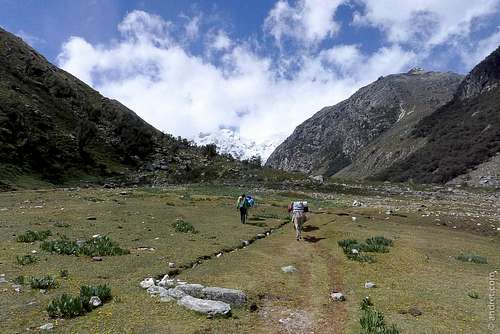
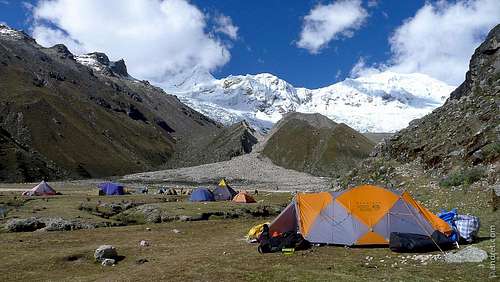

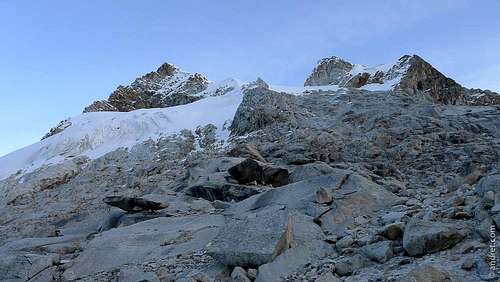
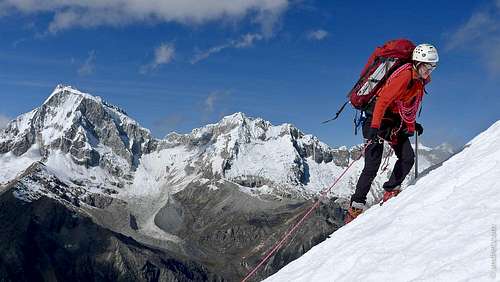
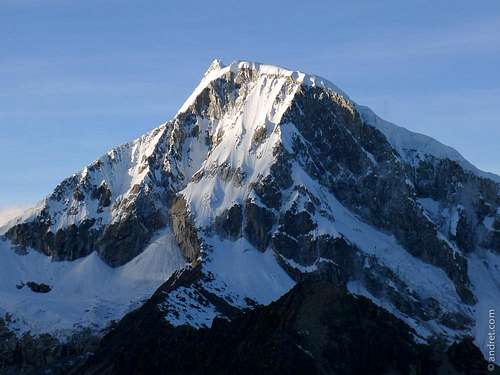


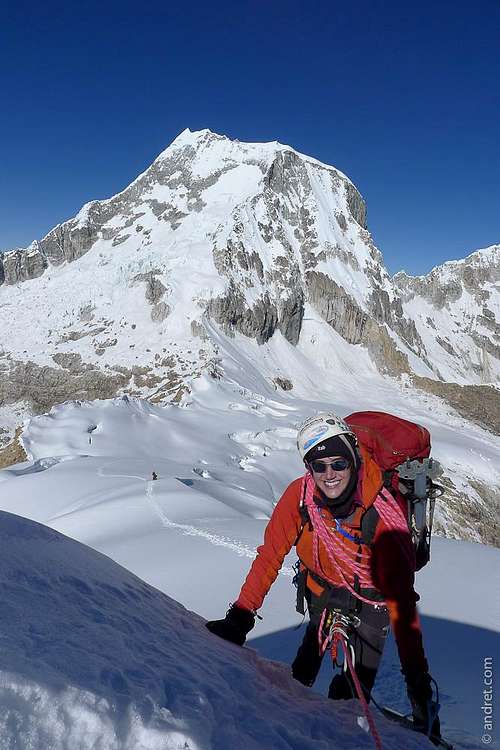

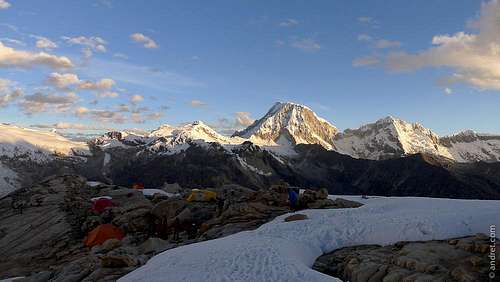





Comments
Post a Comment